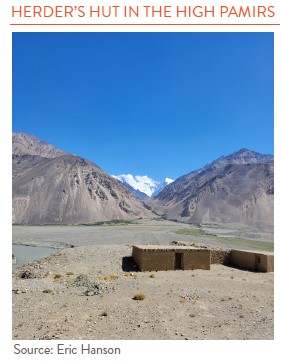
Tajikistan is not on everyone’s bucket list. In fact, most people are hard pressed to find the country on a map. But if you are interested in the high mountains of Asia, from the Himalayas to the Karakorum, the Hindu Kush, and the Pamirs, then Tajikistan is a prime destination. The Pamir Mountains, a high plateau with an elevation ranging from 8k to 15k feet, is the true Roof of the World, higher even than the Tibetan Plateau.
With little arable land, the terrain is unforgiving. Often the only humans you see in the Pamirs are solitary herders moving their sheep, cattle, and yaks to high pastures in the summer and back down to lower levels in the winter. Yang Xin and I spent three weeks driving the Pamir Highway, a legendary road, part dirt track and part paved roads built by the Russians back in the mid-1900s and only nominally improved since. Here are some political and economic observations about Tajikistan.
To understand foreign policy in Central Asia you have to understand “spheres of influence.” In October 1962, the U.S. faced down Soviet missiles in Cuba. Cuba was definitely within our sphere of influence, and we considered it off limits to the USSR. In 1991, the Soviet Union collapsed, and Russia lost all the countries on its periphery – Eastern Europe, the Caucasus, and Central Asia, but the feeling remained that these areas were still very much within its sphere of influence.
Tajikistan is walking a narrow tightrope with Russia today. It wants to preserve its distance and independence from Moscow, but at the same time Russian is widely spoken in the country, Russian TV dominates the airwaves, and Russia is a major economic factor. It is estimated that 20% of the Tajik population live and work in Russia, sending much needed remittances back to the country. Russia maintains a military base in Tajikistan with approximately five thousand troops.
A second observation is that the Great Game is on again. The first Great Game in the 1800s pitted Russia against England. Russia was worried England wanted to cause trouble in Central Asia, an area where it had recently consolidated its influence. And England was worried Russia coveted its very profitable “Jewel in the Crown” – India. By 1900, the Game ended in a stalemate, with Russia on one side of Afghanistan and England on the other.
Today the Great Game for influence in Central Asia is between Russia and China. The United States would like to compete, but it is a distant player. Chinese electric cars, buses, and consumer goods are an ever greater presence in Tajikistan, and Chinese aid to rebuild roads and infrastructure far exceeds Russia’s largesse. Long-term, China may very well win the battle for influence in Central Asia. It may be an oversimplification, but China has a powerful army and a powerful economy whereas Russia has only a powerful army – and even this is being tested today in Ukraine. China is comfortable playing the long game in Tajikistan.

And finally, some boots on the ground observations. If you want to know what the world’s toughest vehicles are, go to the toughest places. The Pamir Highway certainly qualifies as a tough place. You have to have a reinforced four wheel drive in the Pamirs and the vehicle of choice, hands down, is the Toyota Landcruiser. Nothing holds up as well. (Truth in advertising – no payment was received for this shoutout!). And if you are thinking of taking a soft drink along on the trip, don’t even think of Coke. The drink of choice in Tajikistan is RC Cola, a brand most Americans haven’t drunk in decades. But they certainly know it in Tajikistan. A 12-ounce bottle of RC has a whopping eleven teaspoons of sugar, giving consumers a real jump start on a diabetes diagnosis.